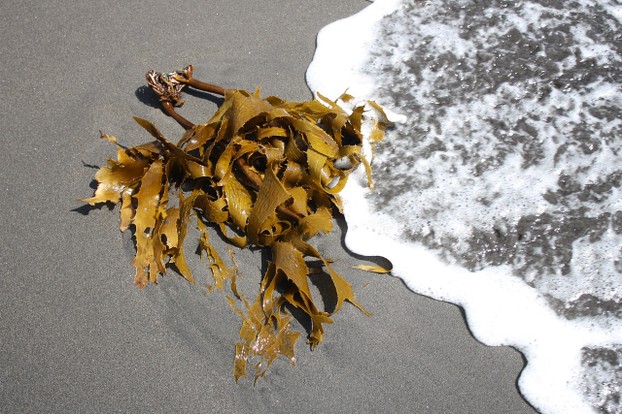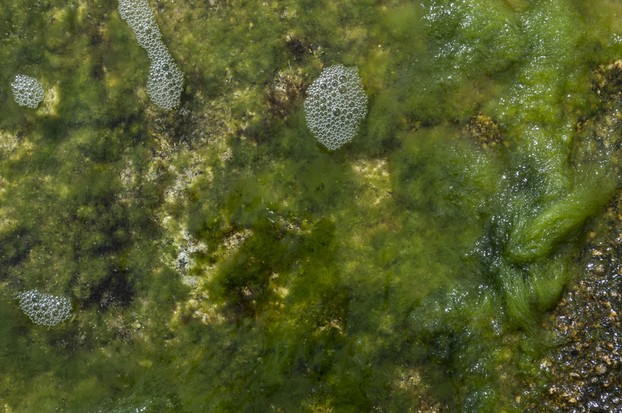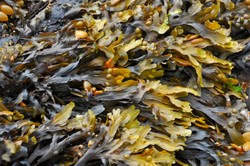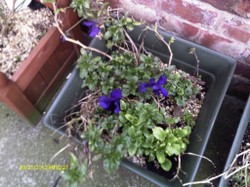Dulce makes a tasty, snack, chewy and salty, and it is well-known delicacy in Ireland, where it is known as dillisk, a word that means water leaf in the Irish tongue.There are two main kinds,dulce and pepper dulce.The advantage of dulce, which is a red seaweed,is that it can be simply cooked, and the same goes for pepper dulce as well.John Wright, whose book,Edible Seashore, part of the esteemed River Cottage series, is mentioned below. But mostly it is dried and used as a snack.
Carragheen, Chondrus crispus, is a red seaweed easily collected in rock pools.It is not normally eaten alone, but it can be used by vegans as a source of non-animal thickening agent. If not going to be used immediately it can be dried, but if you dry it in your oven it will leave a lasting odour in your house,so dry it on sheets outdoors. Dried caragheen can be reconstituted by adding a little water and leaving it for a few minutes. A way of using carragheen,sometimes known as Irish moss or Carageeen moss, is to thicken stews. The way to do this is to hang it in a net bag in the stew for five minutes. It can also be dried and pressed into sheets of nori.
The final seaweed is laver, Porphyra ssp, yet another red seeweed [there are five species of laver that is a popular delicacy in Wales, where it is boiled down into the delicacy laverbread. This process takes between five and ten hours, to produce a black but savoury colloid that is used in a range of dishes. One good use is to mix laver with oatmeal flour and form it into cakes,which are then fried in bacon fat and served with cockles. It is said to make a tasty breakfast dish.
A range of recipes for these useful food stuffs can be found in Edible Seashore by John Wright.











 Pilgrimage. A review20 days ago
Pilgrimage. A review20 days ago
 Leo the Fourteenthon 05/09/2025
Leo the Fourteenthon 05/09/2025
 The Melsonby Hoardon 03/25/2025
The Melsonby Hoardon 03/25/2025



Comments
It has a vinegarish flavour and an Apple tang.
The second paragraph to the second subheading, Kelp and sea lettuce, alerts us to a "dressing of cider apple vinegar and walnut oil."
What does such a dressing look like and taste like?
No. We have never, sampled sea, salt ice cream?
Thank you for your comment below in answer to my previous observation and question.
The Halen Môn site has salty recipes. One recipe particularly intrigues me: sea-salt ice cream.
Might you and your family ever have had Halen Môn sea-salt ice cream?
Its taste is salty, but it is said to be very pure.
Thank you for your comment below on Jan. 21, 2021, in answer to my previous observation and question Jan. 20, 2021.
Online sources extol Halen Môn ("salt Anglesey" literally) as organic and uncluttered by other ingredients.
Might it have a distinct taste or -- ;-{ -- might all salts basically have one, similar salty scent, taste, texture?
I don't know salt from sea lettuce. We use sea salt. Halen Mon [Anglesey sea salt] is my preferred type.
frankbeswick, Thank you for all the fine practicalities and products.
What with seaweed desserts as a possibility, I'm looking forward to coming up with an all-seaweed, multi-course meal.
Do you prefer sea salt from seawater or sea salt from sea lettuce?
Sea greens are becoming increasingly popular choices in high class restaurants.
Probably, but they specialize in hamburgers. People just would not give it a chance.